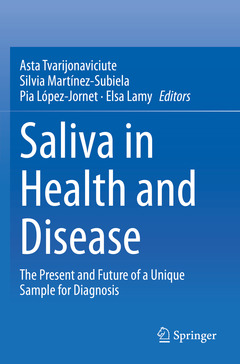Saliva in Health and Disease, 1st ed. 2020 The Present and Future of a Unique Sample for Diagnosis
Coordonnateurs : Tvarijonaviciute Asta, Martínez-Subiela Silvia, López-Jornet Pia, Lamy Elsa

Saliva as a unique sample for health assessment is gaining attention among researchers of different fields in the last 20 years; being reflected in an impressive increase in the number of papers published studying saliva from different biological aspects in human and veterinary species. Once deemed merely a digestive juice is now considered a biological fluid capable of communicating information about physiopathological processes occurring in organisms, since saliva has been shown to contain molecular and bacterial compounds that can change in response to local and systemic pathologies. Furthermore, the interest of saliva as a diagnostic, prognostic and monitoring biofluid is forced by its non-invasive nature being of easy and inexpensive sampling, involving only minimal discomfort and allowing the collection of multiple/repeated specimens at anytime, anywhere and without need for specialized staff.
In this contributed volume, the authors bring together, summarize and reflect the generated knowledge about saliva as a source of biomarkers for health and welfare evaluation in humans and animal models. This volume also highlights the importance of confounding factors, such as sampling methods, flow, total protein content, contamination, or storage. This book will serve as a manual for graduates, practitioners and researchers by providing general ideas about the possibilities and utilities of saliva in clinical practice or investigation, and indicating the main cautions each should have in mind before saliva usage.1. Saliva basics
1.1. Salivary glands' anatomy and physiology
1.2. Saliva in ingestive behavior research: association with oral sensory perception and food intake
2. Saliva as a non-invasive sample: Pros and Cons.
3. Methodology assays for the salivary biomarkers’ identification and measurement
4. Salivary biomarkers in oral and systemic pathologies
4.1. The role of saliva in dental practice
4.2. Salivary biomarkers in respiratory diseases
4.3. Salivary biomarkers in neurologic diseases
4.4. Salivary biomarkers in the diagnosis and monitoring of metabolic and endocrine diseases
4.5. Salivary markers in inflammatory and autoimmune diseases
4.6. Salivary biomarkers in oral and systemic pathologies. Kidney diseases
4.7. Salivary diagnosis of infectious diseases
4.8. Salivary markers in systemic and oral cancer
4.9. Saliva in sport sciences
5. Salivary biomarkers in welfare studies
6. The future of saliva as an analytical sample
Silvia Martinez-Subiela received her degree in Veterinary Medicine from University of Murcia in 1999 and her Ph.D. in Veterinary Medicine in 2003. She is currently Associate Professor at the Medicine and Surgery Department of the University of Murcia and member for the Service of Veterinary Diagnostic Laboratory of Murcia University (accredited by European Society of Veterinary Clinical Pathology). During her studies she was awarded several scholarships for excellence: University of Murcia and National Excellence Awards for the best academic qualifications in Veterinary degree studies, University of Murcia Excellence Award for the best PhD thesis in Veterinary studies and The Veterinary Journal 2003 Junior scientist literary Prize. She has 18 years of experience in the development and validation of assays for biomarker quantification in serum and other fluids such as saliva, mainly in the field of acute phase proteins, obesity and stress. She has over 130 publications in high impact journals of this field with an H-index of 34 and has participated in 12 research projects. She is a member of the editorial boards of 2 veterinary journals and a regular revie
Highlights saliva as a substitute for blood in the management of local and systemic pathologies
Discusses the precautions and confounding factors, which should be taken in account when using saliva
Contains and discusses data humans studies and animal models
Date de parution : 04-2021
Ouvrage de 326 p.
15.5x23.5 cm
Disponible chez l'éditeur (délai d'approvisionnement : 15 jours).
Prix indicatif 158,24 €
Ajouter au panierDate de parution : 04-2020
Ouvrage de 326 p.
15.5x23.5 cm
Disponible chez l'éditeur (délai d'approvisionnement : 15 jours).
Prix indicatif 158,24 €
Ajouter au panierThèmes de Saliva in Health and Disease :
Mots-clés :
Diagnostics; Biomarkers; Oral Pathologies; Systemic Pathologies; Human Samples; Animal Models



